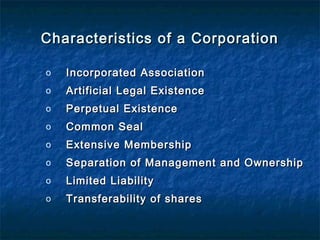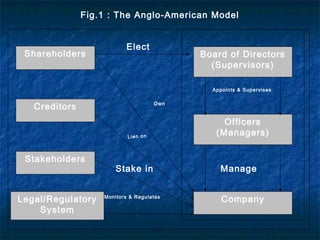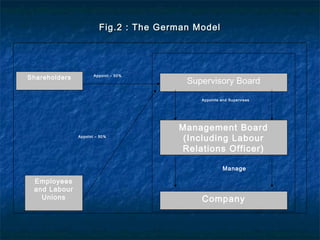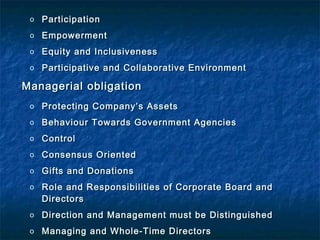Chapter 2 corporate goverance
- 1. CHAPTER 2CHAPTER 2 THE THEORYTHE THEORY AND PRACTICEAND PRACTICE OFOF CORPORATECORPORATE GOVERNANCEGOVERNANCE
- 2. OBJECTIVESOBJECTIVES Over the past three decades, the concept ofOver the past three decades, the concept of corporate governance has gone through acorporate governance has gone through a metamorphosis. Theoretically, from one thatmetamorphosis. Theoretically, from one that was related to agency cost, it is now perceivedwas related to agency cost, it is now perceived to encompass everyone’s interests. Thisto encompass everyone’s interests. This chapter discusses the theoretical basis,chapter discusses the theoretical basis, mechanisms and the divergent models ofmechanisms and the divergent models of corporate governance and culminates in thecorporate governance and culminates in the identification of an ideal corporation.identification of an ideal corporation.
- 3. CHAPTER OUTLINECHAPTER OUTLINE The Concept of CorporationThe Concept of Corporation Theoretical Basis of Corporate GovernanceTheoretical Basis of Corporate Governance Agency TheoryAgency Theory Stewardship TheoryStewardship Theory Stakeholder TheoryStakeholder Theory Corporate Governance MechanismsCorporate Governance Mechanisms Corporate Governance SystemsCorporate Governance Systems What Is Good Corporate GovernanceWhat Is Good Corporate Governance Obligation to Society at LargeObligation to Society at Large Obligation to InvestorsObligation to Investors Obligation to EmployeesObligation to Employees Obligation to CustomersObligation to Customers Managerial ObligationManagerial Obligation
- 4. What is a Corporate?What is a Corporate? The term “corporate” refers to an association ofThe term “corporate” refers to an association of many persons, who contribute money or money’smany persons, who contribute money or money’s worth to a common stock and employ it in someworth to a common stock and employ it in some trade or business, and who share the profit andtrade or business, and who share the profit and loss arising therefrom. The common stocks soloss arising therefrom. The common stocks so contributed is denoted in money and is the capitalcontributed is denoted in money and is the capital of the company. The persons who contribute it, orof the company. The persons who contribute it, or to whom it belongs, are its members. Theto whom it belongs, are its members. The proportion of the capital to which each member isproportion of the capital to which each member is entitled is his share. Shares are alwaysentitled is his share. Shares are always transferable, although the right to transfer them istransferable, although the right to transfer them is often more or less restricted.often more or less restricted.
- 5. What is Governance?What is Governance? Governance is the process of decision makingGovernance is the process of decision making and the process by which decisions areand the process by which decisions are implemented or not implemented.implemented or not implemented.
- 6. Characteristics of a CorporationCharacteristics of a Corporation o Incorporated AssociationIncorporated Association o Artificial Legal ExistenceArtificial Legal Existence o Perpetual ExistencePerpetual Existence o Common SealCommon Seal o Extensive MembershipExtensive Membership o Separation of Management and OwnershipSeparation of Management and Ownership o Limited LiabilityLimited Liability o Transferability of sharesTransferability of shares
- 7. Theoretical Basis of CorporateTheoretical Basis of Corporate GovernanceGovernance o Agency TheoryAgency Theory o Problems with the Agency TheoryProblems with the Agency Theory o Stewardship TheoryStewardship Theory o Shareholder Vs Stakeholder ApproachesShareholder Vs Stakeholder Approaches o Stakeholder TheoryStakeholder Theory o Criticisms of the Stakeholder TheoryCriticisms of the Stakeholder Theory o Sociological TheorySociological Theory
- 8. Agency TheoryAgency Theory Management as agents of stockholdersManagement as agents of stockholders Agency Cost raise issues (Trade-off)Agency Cost raise issues (Trade-off) Mechanisms reducing agency costMechanisms reducing agency cost Fair and Accurate Financial DisclosuresFair and Accurate Financial Disclosures Financial and Non-Financial DisclosuresFinancial and Non-Financial Disclosures Efficient and Independent BoDsEfficient and Independent BoDs
- 9. Stewardship TheoryStewardship Theory Managers are trustworthyManagers are trustworthy Managers attach significant value to theirManagers attach significant value to their own personal reputationsown personal reputations Manager is steward of principalManager is steward of principal Steward will do good for organizationSteward will do good for organization Controls will demotivate stewardsControls will demotivate stewards
- 10. The theory definesThe theory defines Managers are not motivaed by individualManagers are not motivaed by individual goals but with the objectives of principlesgoals but with the objectives of principles A steward will choose the interessts ofA steward will choose the interessts of his/her organization, and will not entertainhis/her organization, and will not entertain self-serving behaviorself-serving behavior Control can be potentiallyControl can be potentially counterproductivecounterproductive
- 11. Behavioural DifferencesBehavioural Differences THEORY AGENCY STEWARDSHIP Managers act as Agents Stewards Governance Approach Materialistic Sociological and Psychological Behaviour Pattern o Individualistic o Opportunistic o Self-serving o Collectivistic o Pro-organisational o Trustworthy Managers motivated by Their own objectives Principal’s objectives Manager’s and Principal’s Interests Differ Converge Management Structures Monitor and control Facilitate and empower Owners’ Attitude Risk Avoidance Risk taken Principal – Manager Relationship based on Control Trust
- 12. Psychological MechanismsPsychological Mechanisms PSYCHOLOGICAL RESPONSES AGENCY THEORY STEWARDSHP THEORY Motivation o Lower order needs o Extrinsic needs o Higher order needs o Intrinsic needs Social comparison Compatriots Principal Attachment Little attachment to company Great attachment to company Power Institutional Personal
- 13. Situational MechanismsSituational Mechanisms SITUATIONAL RESPONSES AGENCY THEORY STEWAREDSHIP THEORY Management Philosophy Control oriented Involvement oriented While dealing with increasing Uncertainty and risk Greater controls More supervisions Training and empowering people Making jobs to be more challenging and motivating Risk orientation Through a system of control Through trust Time frame Short term based Long term based Objective Cost control Improving performance Cultural differences Individualism Large power Collectivism Small power distance
- 14. Shareholder Vs. StakeholderShareholder Vs. Stakeholder TheoryTheory • Shareholders are investors of the firmShareholders are investors of the firm • Stakeholders are all-interest groupsStakeholders are all-interest groups • Employees, customers, dealers, governmentEmployees, customers, dealers, government and the society at largeand the society at large • Ethics of care, theory of property rights andEthics of care, theory of property rights and so onso on • Not applicable in practiceNot applicable in practice • CriticismCriticism • Difficulty in defining the conceptDifficulty in defining the concept • Who is genuine stakeholder?Who is genuine stakeholder? • Practical?Practical?
- 15. Sociological TheorySociological Theory • Focuses on:Focuses on: • Board CompositionBoard Composition • Power and Wealth Distribution in SocietyPower and Wealth Distribution in Society • Power in few hands (privilege class)Power in few hands (privilege class) • Challenge to equity and social progressChallenge to equity and social progress • To promote equity and fairnessTo promote equity and fairness • Board composition, financial reporting,Board composition, financial reporting, disclosure and auditingdisclosure and auditing
- 16. Corporate Governance MechanismsCorporate Governance Mechanisms o The Importance of Corporate GovernanceThe Importance of Corporate Governance o Contemporary Corporate Governance SituationContemporary Corporate Governance Situation o Growing Awareness and Societal ResponsesGrowing Awareness and Societal Responses Corporate Governance SystemsCorporate Governance Systems o Anglo-American ModelAnglo-American Model o The German ModelThe German Model o The Japanese ModelThe Japanese Model o Indian Model of Corporate GovernanceIndian Model of Corporate Governance
- 17. Fig.1 : The Anglo-American Model Company Officers (Managers) Board of Directors (Supervisors) Legal/Regulatory System Stakeholders Creditors Shareholders Elect Monitors & Regulates Lien on Own Stake in Appoints & Supervises Manage
- 18. Fig.2 : The German ModelFig.2 : The German Model Company Management Board (Including Labour Relations Officer) Supervisory Board Employees and Labour Unions Shareholders Appoints and Supervises Appoint – 50% Appoint – 50% Manage
- 19. Fig.3 : The Japanese ModelFig.3 : The Japanese Model Company Executive Management (Primarily Board of Directors) President Supervisory Board (Including President) Main Bank Shareholders Provides Loans elect Ratifies the President’s Decisions Consults Manages Provides Loans Owns Own Provides Managers Monitors & Acts in Emergencies
- 20. What Is Good CorporateWhat Is Good Corporate Governance?Governance? Obligation to society at largeObligation to society at large o National InterestNational Interest o Political Non-alignmentPolitical Non-alignment o Legal CompliancesLegal Compliances o Rule of LawRule of Law o Honest and Ethical ConductHonest and Ethical Conduct o Corporate CitizenshipCorporate Citizenship o Ethical BehaviourEthical Behaviour o Social ConcernsSocial Concerns o Corporate Social ResponsibilityCorporate Social Responsibility
- 21. o Environment-friendlinessEnvironment-friendliness o Health, Safety and Working EnvironmentHealth, Safety and Working Environment o CompetitionCompetition o TrusteeshipTrusteeship o AccountabilityAccountability o Effectiveness and EfficiencyEffectiveness and Efficiency o Timely ResponsivenessTimely Responsiveness o Corporations Should Uphold the Fair Name of the CountryCorporations Should Uphold the Fair Name of the Country Obligation to investorsObligation to investors o Towards ShareholdersTowards Shareholders o Measures Promoting Transparency and InformedMeasures Promoting Transparency and Informed Shareholder ParticipationShareholder Participation o TransparencyTransparency o Financial Reporting and RecordsFinancial Reporting and Records
- 22. Obligation to customersObligation to customers o Quality of Products and ServicesQuality of Products and Services o Products at Affordable PricesProducts at Affordable Prices o Unwavering Commitment to CustomerUnwavering Commitment to Customer SatisfactionSatisfaction Obligation to employeesObligation to employees o Fair Employment PracticesFair Employment Practices o Equal-opportunities EmployerEqual-opportunities Employer o Encouraging Whistle BlowingEncouraging Whistle Blowing o Humane TreatmentHumane Treatment
- 23. o ParticipationParticipation o EmpowermentEmpowerment o Equity and InclusivenessEquity and Inclusiveness o Participative and Collaborative EnvironmentParticipative and Collaborative Environment Managerial obligationManagerial obligation o Protecting Company’s AssetsProtecting Company’s Assets o Behaviour Towards Government AgenciesBehaviour Towards Government Agencies o ControlControl o Consensus OrientedConsensus Oriented o Gifts and DonationsGifts and Donations o Role and Responsibilities of Corporate Board andRole and Responsibilities of Corporate Board and DirectorsDirectors o Direction and Management must be DistinguishedDirection and Management must be Distinguished o Managing and Whole-Time DirectorsManaging and Whole-Time Directors
- 24. Johnson & Johnson’s excellent Credo exemplarilyJohnson & Johnson’s excellent Credo exemplarily epitomises what an ideal corporate should aspireepitomises what an ideal corporate should aspire to be.to be. Our CredoOur Credo We believe our first responsibility is to the doctors, nursesWe believe our first responsibility is to the doctors, nurses and patients,and patients, to mothers and fathers and all others who use our productsto mothers and fathers and all others who use our products and services.and services. In meeting their needs everything we do must be of highIn meeting their needs everything we do must be of high quality.quality. We must constantly strive to reduce our costsWe must constantly strive to reduce our costs in order to maintain reasonable prices.in order to maintain reasonable prices. Customers' orders must be serviced promptly andCustomers' orders must be serviced promptly and accurately.accurately. Our suppliers and distributors must have an opportunity toOur suppliers and distributors must have an opportunity to make a fair profit.make a fair profit.
- 25. We are responsible to our employees,We are responsible to our employees, the men and women who work with us throughout the world.the men and women who work with us throughout the world. Everyone must be considered as an individual.Everyone must be considered as an individual. We must respect their dignity and recognize their merit.We must respect their dignity and recognize their merit. They must have a sense of security in their jobs.They must have a sense of security in their jobs. Compensation must be fair and adequate,Compensation must be fair and adequate, and working conditions clean, orderly and safe.and working conditions clean, orderly and safe. We must be mindful of ways to help our employees fulfill theirWe must be mindful of ways to help our employees fulfill their family responsibilities.family responsibilities. Employees must feel free to make suggestions and complaints.Employees must feel free to make suggestions and complaints. There must be equal opportunity for employment, developmentThere must be equal opportunity for employment, development and advancement for those qualified.and advancement for those qualified. We must provide competent management,We must provide competent management, and their actions must be just and ethical.and their actions must be just and ethical.
- 26. We are responsible to the communities in which we live and workWe are responsible to the communities in which we live and work and to the world community as well.and to the world community as well. We must be good citizens – support good works and charitiesWe must be good citizens – support good works and charities and bear our fair share of taxes.and bear our fair share of taxes. We must encourage civic improvements and better health andWe must encourage civic improvements and better health and education.education. We must maintain in good orderWe must maintain in good order the property we are privileged to use,the property we are privileged to use, protecting the environment and natural resources.protecting the environment and natural resources. Our final responsibility is to our stockholders.Our final responsibility is to our stockholders. Business must make a sound profit.Business must make a sound profit. We must experiment with new ideas.We must experiment with new ideas. Research must be carried on, innovative programs developedResearch must be carried on, innovative programs developed and mistakes paid for.and mistakes paid for. New equipment must be purchased, new facilities provided andNew equipment must be purchased, new facilities provided and new products launched.new products launched.
- 27. Reserves must be created to provide for adverse times.Reserves must be created to provide for adverse times. When we operate according to these principles,When we operate according to these principles, the stockholders should realize a fair return.the stockholders should realize a fair return. Johnson &Johnson & JohnsonJohnson


























